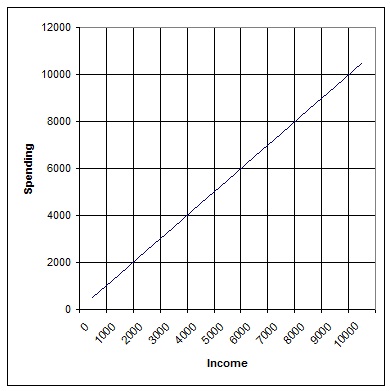The Short-Run Macro Model:
Problem 1. Given that C = 500 + 0.8*YD fill in the table below. YD is disposable income and net exports are equal to 0.
|
Income or GDP
|
Taxes
|
Disposable Income
|
Consumption
|
Investment
|
Gov't Purchases
|
Aggregate Expenditure
|
|
2,000
|
1000
|
|
|
600
|
300
|
|
|
2,500
|
1000
|
|
|
600
|
300
|
|
|
3,000
|
1000
|
|
|
600
|
300
|
|
|
3,500
|
1000
|
|
|
600
|
300
|
|
|
4,000
|
1000
|
|
|
600
|
300
|
|
|
4,500
|
1000
|
|
|
600
|
300
|
|
a. What is the equilibrium level of GDP in this economy?
b. Are inventories increasing or decreasing when GDP is 4,000? 2,000? By how much are they changing?
Problem 2. Consider the short-run macro model where YD is disposable income and NX is net exports
C = 1300 + 0.75 YD
G = 400
T = 400
I = 600
NX = 0
a. What is the MPC (marginal propensity to consume) in this model? What does this tell us?
b. What is autonomous consumption spending with respect to disposable income in this model? What does this tell us?
c. Graph the consumption income line with consumption on the y-axis and income on the x-axis.

d. On the same graph show the aggregate expenditure line.
e. Using the graph, what is the equilibrium GDP?
f. Suppose real GDP equals 4000.
i) At this level, what is total spending?
ii) What is consumption?
iii)What is the change in inventories?
g. Suppose GDP equals 10,000.
i) At this level, what is total spending?
ii) What is consumption?
iii)What is the change in inventories?
h. On the graph show the change in inventories.
Problem 3. Consider a new model
C = 1200 + 0.80 YD
G = 300
T = 500
I = 400
NX = -100
a. What is the MPC?
b. What is autonomous consumption spending with respect to income (not disposable income)?
c. What is consumption when income equals 0? What is consumption when disposable income equals 0?
d. Derive the equilibrium level of income algebraically.
e. What is the expenditure multiplier in this model?
f. How much will an increase in investment spending of 200 increase GDP?
g. What is the tax multiplier in this model?
h. If taxes are reduced by 200 how will GDP change?
Problem 4. Consider the table below.
a. What is the consumption function for this economy? Hint: the consumption function is linear.
|
Income
|
Taxes
|
Disposable Income
|
Consumption
|
|
7,000
|
2,000
|
|
5,750
|
|
8,000
|
2,000
|
|
6,500
|
|
9,000
|
2,000
|
|
7,250
|
|
10,000
|
2,000
|
|
8,000
|
b. If the equilibrium GDP is 12,000, what is non-consumption spending (I+G+NX)?
Problem 5. The MPC is 0.8 and investment increases by 1000. How much will spending increase in year 1? year 2? and year 3? What will be the total increase in GDP over three years?
Problem 6. Calculate the change in GDP from an decrease in investment of $20 million when the MPC is:
a) 0.6;
b) 0.75; and
c) 0.8
Problem 7. Calculate the change in GDP from an decrease in taxes of $20 million when the MPC is
a) 0.6;
b) 0.75; and
c) 0.8